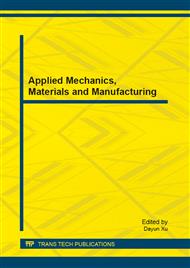[1]
L. Pugi, D. Fioravanti and L. Rindi: Modelling the longitudinal dynamics of long freight trains during the braking phase, 12th IFToMM World Congress, Besançon (France), June18-21 2007, http: /iftomm. appsci. queensu. ca/proceedings/proceedings_WorldCongress/WorldCongress07/articles/sessions/papers/A822. pdf (2007).
Google Scholar
[2]
X. Zhuan: Optimal Handling and Fault-tolerant Speed Regulation of heavy Haul Trains, Doctoral Thesis, Univ. of Pretoria (2006).
Google Scholar
[3]
I. Zobory, H.G. Reimerdes and E. Békefy: Longitudinal Dynamics of Train Collisions-Crash Analysis, 7th Mini Conf. on Vehicle System Dynamics, Identification and Anomalies, Budapest, 6-8 Nov. 2000, http: /www. railveh. bme. hu/Publikaciok/Zobory-Reim-Bek-Mar-Nem_Mini-7. pdf, pp.89-110 (2000).
Google Scholar
[4]
C. Cruceanu: Train braking (Chapter 2) in Reliability and Safety in Railway, InTech, Editor Xavier Perpinia, pp.29-74 (2012).
Google Scholar
[5]
UIC leaflet 540: Brakes - Air Brakes for freight trains and passenger trains, 5th edition (2006).
Google Scholar
[6]
P. Belforte, F. Cheli, G. Diana and S. Melzi: Numerical and experimental approach for the evaluation of severe longitudinal dynamics of heavy freight trains, Vehicle System Dynamics, 46: 1, p.937—955 (2008).
DOI: 10.1080/00423110802037180
Google Scholar
[7]
A. Nasr and S. Mohammadi: The effects of train brake delay time on in-train forces, Proc. IMechE Vol. 224 Part F: J. Rail and Rapid Transit, pp.523-534 (2010).
DOI: 10.1243/09544097jrrt306
Google Scholar
[8]
T. Piechowiak: Verification of pneumatic railway brake models, Vehicle System Dynamics, 48: 3, p.283—299 (2010).
DOI: 10.1080/00423110902780622
Google Scholar
[9]
L. Cantone, E. Crescentini, R. Verzicco and V. Vullo: A numerical model for the analysis of unsteady train braking and releasing manoeuvres, Proc. IMechE Vol. 223 Part F: J. Rail and Rapid Transit, pp.305-317 (2009).
DOI: 10.1243/09544097jrrt240
Google Scholar
[10]
L. Pugi, M. Malvezzi, B. Allotta, L. Bianchi and P. Presciani: A parametric library for the simulation of a Union Internationale des Chemins de Fer (UIC) pneumatic braking system, Proc. IMechE Vol. 218 Part F: J. Rail and Rapid Transit, pp.117-132 (2004).
DOI: 10.1243/0954409041319632
Google Scholar
[11]
L. Pugi, A. Palazzolo and D. Fioravanti: Simulation of railway brake plants: an application to SAADKMS freight wagons, Proc. IMechE Vol. 222 Part F: J. Rail and Rapid Transit, pp.321-329 (2008).
DOI: 10.1243/09544097jrrt118
Google Scholar
[12]
UIC leaflet 541-05: Brakes – Specifications for the construction of various brake parts – Wheel Slide Protection device, 2nd edition (2005).
Google Scholar
[13]
UIC leaflet 544-1: Brakes - Braking power, 4th edition (2004).
Google Scholar
[14]
C. Cruceanu, R. Oprea, M. Spiroiu, C. Crăciun and S. Arsene: A Model for the Dynamic Longitudinal Reactions in the Body of a Braked Passenger Train, Proceedings of the 2009 Int. Conference On Scientific Computing CSC'09, CSREA Press, Las Vegas, USA, pp.58-64 (2009).
Google Scholar


